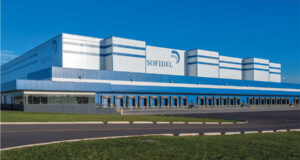In the digitization era, the “Digital Twin” has evolved as an integral part of Industry 4.0. A Digital Twin is a digital replica of the physical assets, processes, and systems, and these replicas can be used for many purposes.
Andritz has more than 25 years of process modeling experience in developing high-fidelity simulation models—Digital Twins of the process plant. These models, with added live plant data as an input, provide comprehensive insight into the current state of processes, helping operations in better decision-making. A Digital Twin for the evaporation plant is one example where the simulation model is connected to real-time plant data to continuously solve the process’ instantaneous mass and energy balance. Then, the Digital Twin applies the instantaneous balance data and further calculations to improve operations decisions and plant performance.

Digital Twins can be both data-based models, using historical data; and physical/first principles-based models, such as the Andritz IDEAS Digital Twin. IDEAS is a simulation software package built by Andritz and used as the foundation for a range of simulation services, including the Digital Twin for the pulp and paper and other industries. This article highlights features of the Evaporator Digital Twin and how it helps customers make optimal operational decisions.
The objective is to use live plant data to get detailed insights on process parameters by running simulations and “what-if” scenarios. To do so, we run the simulation model in real-time using selected, actual plant conditions as inputs to the model. The solution thus obtained provides difficult-to-measure (or impossible-to-measure) process data that can help engineers with process diagnostics and proactive decision-making. A Digital Twin application for a process plant is analogous to an MRI of the human body—both can be used to find otherwise undetectable anomalies that help in making accurate diagnoses.
IDEAS DIGITAL TWIN
IDEAS Digital Twin development and operation involve the steps detailed below (Fig.1):
• Identify and read reliable and necessary inputs
• Screen and validate input data
• Simulation model development and validation
• Solution strategy and predictions
• Outputs to control system and historian
The Digital Twin draws its input data from multiple sources such as OPC servers, plant historian, etc. Identifying reliable and necessary inputs is a critical step that requires process expertise and operational experience. The strategy for solving or converging a simulation model depends on the reliability of plant data and the desired solution objectives. Different data cleansing techniques are used to process the input data to filter noise and error associated with the measurements. The inputs are then fixed in the Digital Twin model, which has been built with engineering information such as Piping and Instrumentation Diagrams (P&IDs) and process-specific equations. The fidelity of the model determines the accuracy of the simulation results and other predictions. The steps set the foundation to implement the Digital Twin technology for applications such as:
• Key Performance Indicators (KPI)
• Performance Monitoring and Diagnostics
• Virtual Transmitters
• Predictions/Operational Guidance
APPLICATION FOR THE EVAPORATION PLANT
The simulation model has been developed as per the plant specification using the IDEAS platform. A wide range of process unit operations including evaporators are modeled with graphical user-based IDEAS objects. Custom design equations from process experts are also incorporated to calculate performance and design-specific parameters. Process and simulation experts validate the model with design and operations data. When connected to the live plant data, the model solves the detailed mass and energy balance. It also solves many hard-to-measure process variables such as heat transfer coefficients and heat transfer efficiencies for each effect. Many such calculated variables are helpful in making operational decisions. The converged solutions, with all custom calculations, optimal parameters, and model-predicted variables are used for analysis, evaluation, and process improvement.

Fig. 1: IDEAS Digital Twin development and operation.
The simulation results are compiled every minute, reported to the control system, and displayed in an informative dashboard. Users can customize the dashboard to specific requirements.
FEATURES AND BENEFITS
The information on the dashboard is configured to help operators understand the current plant conditions. It also highlights the gap between actual and optimal plant operations. This information is in addition to what is already available on the HMI and provides valuable insights into the operation of the plant.
A Digital Twin can provide various categories of information that can be used for making better operational decisions, including:
1. Process Information—An online balance provides a full picture of the flows, solids percentages, temperatures, pressures, etc., throughout the plant. By performing additional calculations in parallel, operators can see the issues and opportunities for improvement, including improved quality (stable black liquor solids percentage), productivity (production), and efficiency (steam economy).
2. Virtual Instruments—The Digital Twin derives numerous variables as a virtual transmitter for key process parameters. Virtual transmitters are ideal to use when:
• No direct measurements are available
• Measurements are off-line or delayed (e.g. lab measurements)
• Measurements are unreliable or error-prone
For the evaporation plant, such measurements include Heat Transfer Coefficients (HTCs) and efficiencies, Boiling Point Rise (BPR), Temperature Difference (∆T), Solids Percentage, Pressure, Flow, Density, Viscosity, etc., in each effect. Several of these measurements are crucial from an operational viewpoint.
3. Data Reconciliation—The Digital Twin is configured with the minimum necessary inputs to solve other process parameters. These calculated parameters can be reconciled with the field instrumentation. The comparison gives an indication of instrument malfunctions and/or calibration requirements. Examples of parameters or instrument readings that can be reconciled with Digital Twin measurements are ∆T, BPR, solids percentage, temperature, steam flows, etc.
4. Washing Predictions—Rather than following a set schedule for washing, the Digital Twin helps the operator perform a wash at the most cost-effective time. The Digital Twin calculates the heat transfer efficiencies for all heating surfaces and forecasts the time until a wash will be required. This enables operators to analyze the fouling, guiding them with the optimal washing frequency and visualizing the quality of each wash cycle. This helps operators plan their workload and improve plant capacity.
5. Operator guidance for…
• Effect 1C Feed Flow t/h, Production t/h
• Maximum allowable operational capacity
• Washing time predictions
• Optimal pressure profile
6. Inventory Calculations—By solving the balance between the incoming weak liquor flow, current plant capacity, and product demand, the Digital Twin performs black liquor and condensate inventory calculations as well.
Digital Twins are instrumental in real-time operations as a proactive decision-making tool for the evaporation process. The Evaporator Digital Twin has demonstrated in the field that it can help operators monitor, analyze, and optimize their process areas. Further, it helps operators compare the key process variables between calculated and physical measurements. These validated and baselined Digital Twin models have incorporated many predictive calculations, providing process and operation teams with a powerful tool for improving operational efficiency.
Evaporation Plants Reap Specific Benefits
When used in the evaporation plant, the Digital Twin simulation model is connected to real-time plant data to continuously solve the process’ instantaneous mass and energy balance, and to predict the optimal washing times. Benefits specific to the evaporator Digital Twin include:
• Online mass and energy balance
• Actual heat transfer efficiencies for each effect
• Scaling status and washing guidance for each effect
• Data reconciliation
• Virtual Instruments for hard-to-measure process variables
• Optimal operating set points
• Inventory management
• Insights into actual plant instrumentation calibration
 Paper 360
Paper 360


